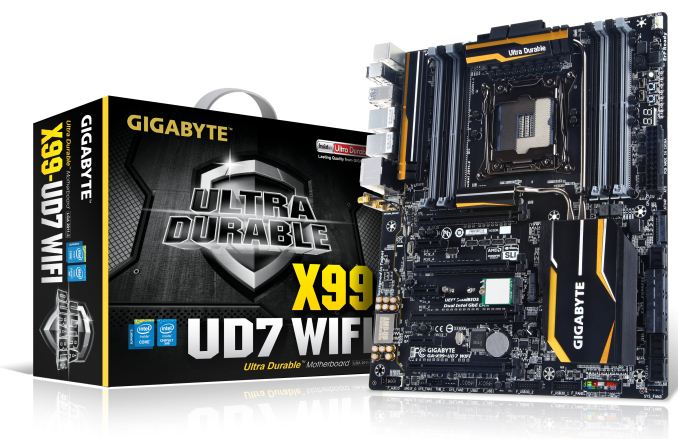The Intel Haswell-E X99 Motherboard Roundup with ASUS, GIGABYTE, ASRock and MSI
by Ian Cutress on September 25, 2014 11:30 AM ESTGIGABYTE X99-UD7 WiFi Conclusion
GIGABYTE and ASUS are locked in a battle with each other to sell the most motherboards this year. Despite a few recent quarters of lower sales, the upswing in the gaming PC market driven by high resolution gaming and renewed interest sees both manufacturers aiming well above 20 million units each, despite a global motherboard sales number about 75-80 million expected for 2014. Each of these companies has a different tactic – ASUS goes for fewer SKUs and focuses on each one, whereas GIGABYTE offers more SKUs to appeal to more users. There are certain challenges in both lineups, and it reflects in the fact that ASUS had two motherboards at the launch of X99 and GIGABYTE aimed at eight.
The X99 UD7-WiFi sits at the top of GIGABYTE’s Ultra Durable line at $310, followed by the similar UD5, then UD4 and UD3. For overclocking there is the X99-SOC Force (and SOC Force-LN2 for extreme overclockers) with gaming relying on the Gaming 5, the Gaming 7 and the Gaming G1. This encompasses a price range from $245 (UD3) to $350 (SOC Force), so while we are aiming at the cheaper end of X99, the more $400 oriented products might be further down the line.
For the X99-UD7 WiFi, GIGABYTE certainly did a number of things right. Supplying WiFi via M.2 is a nice touch, giving a new way to introduce WiFi and then stacking another M.2 for storage on top. By placing the extra circuitry needed, GIGABYTE also ensures that every motherboard across its range can support full-bandwidth four-way GPU configurations. Things like the 30 micron gold pins and extra space for mounting holes also helps reduce issues from screwdrivers that stray or corrosion oriented climates.
Despite all this, my biggest WOW moment with the GIGABYTE X99-UD7 WiFi was the bundled sleeved cables. Perhaps I spend too much time indoors reviewing CPUs and motherboards, but it is a nice touch that needs to be commonplace across all $150 and up motherboards. A positive about the PCIe area is the VGA power being provided by a SATA cable in the right area. The USB 3.0 layout is also good, giving two PCH headers and two Renesas hubs for eight ports on the rear to free up PCIe lanes.
There are some issues to take with the design, such as PCIe storage still being an issue depending on which route you take meaning that only one type can be used. While M.2 WiFi is a cool idea, and our sample had the WiFi antenna kept close to the motherboard by a plastic tool, it is not always wise to have those cables about on the motherboard.
On the benchmark front, the GIGABYTE suffers a little similar to the ASUS by not implementing a totally aggressive MultiCore Turbo throughout any hardware setup. So at stock we had a few numbers lower than expected, although when overclocked this no longer mattered so much. Peak power consumption under load was very good, along with USB speeds, although there was an issue with the audio. Similar to Z97, there is some feature on GIGABYTE boards that causes software-detectable distortion at high volume levels. However if the volume is decreased, peak range is lowered. POST times were also around 25 seconds, matching the X99 WS.
Similar to my Z97 conclusions on GIGABYTE, the BIOS still needs work into making it the interactive tool we need. Fan controls are still lacking in depth, and all we end up with is a glorified menu with relatively few new features. The software is a plus point, making it easy to select the options the user needs however there is room for improvement, especially when it comes to Live Update.
The GIGABYTE X99-UD7 WiFi ends up being a nice motherboard to use with a decent technical portfolio. Delving into the features on an intricate level could come easier to hand, but it won’t stop users plugging in a Haswell-E for a high end gaming system.











62 Comments
View All Comments
nathanddrews - Thursday, September 25, 2014 - link
So which system will serve as the new 2015 gaming review platform? Also, OC + GTX 980 OC Quad-SLI? ;-)techxx - Thursday, September 25, 2014 - link
Why are these things so damn expensive? I was hoping for a Mini-ITX for low $100s.Flunk - Thursday, September 25, 2014 - link
X99 is the workstation/enthusiate platform. You're not likely to see any mini-ITX boards at all, certainly not for $100. Maybe you're thinking of Z97?techxx - Thursday, September 25, 2014 - link
Was right about to correct my post. Yup.Ian Cutress - Thursday, September 25, 2014 - link
We recently reviewed three Z97 mini-ITX at $140 :) http://anandtech.com/show/8276/z97-miniitx-review-...BubbaJoe TBoneMalone - Thursday, September 25, 2014 - link
ASUS Shadowcat x99 mini-itx with usb 3.1 in the works -> http://rog.asus.com/325712014/asus-gaming-motherbo...korben44 - Thursday, September 25, 2014 - link
Sorry, but that Shadowcat is not X99... X99 CPUs do not have onboard graphics chips...editorsorgtfo - Sunday, May 17, 2015 - link
ASRock X99E-ITX/ac but at around 300.just4U - Thursday, September 25, 2014 - link
I'd like to see what they have on the go for MATX.y2kBug - Thursday, September 25, 2014 - link
It's nice to see that these motherboards support Xeon CPUs. Though, does anybody know if Haswell-E Xeons are overclockable? Probably not, but it is nice to know that you can upgrade your machine with 8-Core Xeon in a few years cheaply when big data centers start getting rid of them while upgrading to something new (similar to what is happening to Nehalem/Westmere Xeons now).